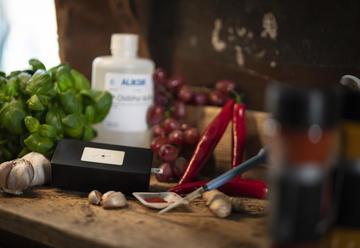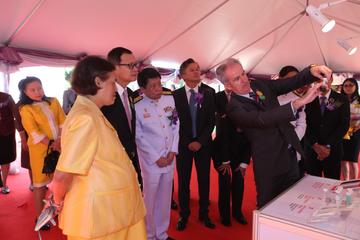Impact
Oxford Chemistry has an outstanding track record in translating fundamental research to effect real-world change. From our ground-breaking work on the lithium-ion battery to a pioneering blood glucose sensor for diabetes, our research vision is to focus on fundamental science to make major, long-term impacts that benefit society.
Read on for profiles of our REF 2021 Impact case studies, which were submitted as part of the UK’s national research assessment exercise. These show the breadth of our research, and how it leads to impact in a diverse range of areas: drug development and healthcare; DNA sequencing; instrument development; the production of new materials; and contributions to the UK economy via commercialisation.
Oxford Nanopore Technologies
Oxford Nanopore was founded in 2005 by Professor Hagan Bayley, Dr Gordon Sanghera and Dr Spike Willcocks, using Professor Bayley’s research on single-molecule nanopore sensing. In this, a single protein nanopore is placed into a membrane and an ionic current driven through it by an applied potential is monitored. When a biological polymer – for example DNA – moves through the nanopore, it causes a measurable change in the ionic current.
The polymer chain of DNA has four bases – G, A, T and C – arranged in a linear sequence. As they move through the pore, changes in the ionic current reflect the order of the different bases, enabling the DNA to be sequenced.
https://www.youtube.com/embed/RcP85JHLmnI
Oxford Nanopore completed the research and development that turned the basic science into usable products, and its technology has revolutionised DNA and RNA sequencing. Low-cost, fast, portable, nanopore-based direct sequencing is now possible in the field and in labs across the world – and even on the International Space Station!
With applications in human genomics, clinical research, microbiology, environmental monitoring and beyond, their fast, low-cost technology has proved a key tool in the sequencing of viruses in public health emergencies, including Ebola in West Africa and Zika virus in Brazil. Since early 2020, their sequencing technology has been used by over 85 countries in the surveillance of COVID-19.
In 2021, Oxford Nanopore floated on the London Stock Exchange where it debuted as the UK's biggest spinout IPO and the fifth-biggest worldwide. With headquarters in Oxford, the company currently employs over 800 people at offices and facilities across Europe, Asia and the United States, and in 2019 opened its state-of-the-art manufacturing facility – the MinION Building – at Harwell Science and Innovation Campus in Oxfordshire.
Read more about Professor Hagan Bayley and the underpinning science and formation of Oxford Nanopore, and discover more about their technology and its applications on the company’s website.
Oxygenases: from Chemistry to Medicine
Collaborative work between the Department of Chemistry and the Nuffield Department of Clinical Medicine has revealed how humans adapt to altered availability of oxygen, for instance at extreme altitudes or because of disease.
This work has led to the identification of new drug targets for diseases, now being pursued by many pharmaceutical companies. Several compounds have been approved for treatment of diseases associated with reduced oxygen availability, including Covid-19.
- Work in Oxford laboratories over the last two decades has demonstrated that small-molecule inhibition of certain oxygen-sensing molecules found in cells (known as HIF prolyl-hydroxylase, or PHD) increases the level of medicinally relevant proteins, making PHDs viable drug targets. This work has led to at least four companies progressing to late-stage clinical trials with PHD-inhibitors as candidates for anaemia treatment, often associated with severe chronic kidney disease.
- Some of the oxygenase inhibitors arising from lab work in Oxford Chemistry are now sold by leading companies. These commercially available products can be used to probe biological function in further biomedical research.
Expertise in Oxford on hypoxia helped lead to the approval of almitrine (an existing drug not previously licensed in the UK) for clinical trials on treatment of severe Covid-19, which began in 2021 at three UK hospitals over four months with results upcoming.

A pulse oximeter can measure the amount of oxygen in the blood.
Refeyn: weighing single molecules with light
The team behind Refeyn – a 2018 spin-out from the Department of Chemistry – is taking us one step closer to quantifying the assembly and interaction of biomolecules in solution at a fundamental level.
Pioneered at the Department of Chemistry by Professors Philipp Kukura and Justin Benesch, mass photometry relies on detecting the light scattered from individual biomolecules to determine their mass.
The accurate mass measurement of proteins and other molecules in their native state, and without the need for labels, presents a simple yet powerful capability that is useful across the life sciences in research and industry.
The fundamental research behind Refeyn has led to a range of scientific and commercial impacts:
- Refeyn’s launch product, the Refeyn OneMP, featured in The Scientist’s Top 10 innovations of 2019, and Refeyn has won awards from the Royal Society of Chemistry, the R&D 100 awards, and the bioProcess UK 4.0 Technology Showcase.
- Their product range now includes the follow up to their launch product, the TwoMP, as well as SamuxMP – a mass photometer optimised for characterising adeno-associated viruses – and the TwoMP Auto, which enables rapid measurement of multiple samples with low sample consumption.
- Refeyn’s instruments are being used for diverse purposes: vaccine development, cell and gene therapy production, and next generation drug discovery.
- AstraZeneca have used Refeyn OneMP in COVID-19 research to study the interaction of the virus’ spike protein with receptors.
Read more about the science behind Refeyn’s work, or explore their product range.

The principle behind mass photometry: the amount of light scattered by molecules in solution that attach to the measurement interface interferes with the directly reflected light, and can be used to directly measure the mass of the molecules.
Electrochemical food sensor
Professor Richard Compton’s research on chemical sensors led to a longstanding collaboration with Zimmer & Peacock (ZP), a UK electrochemical sensor manufacturing company, and the development of a series of handheld devices that measure analytes in food, drink, and water.
Professor Compton’s research group developed an adsorptive stripping voltammetry technique to reliably quantify the concentration of capsaicin (chilli heat) in a sample. Chilli is used throughout the food industry and consistency of strength (heat) is vital. Previous methods to determine chilli strength relied on either organoleptic (taste) testing or high-performance liquid chromatography (HPLC), both of which are time-consuming and costly. However, using Professor Compton’s voltammetry technique ZP were able to produce a sensor that delivers results almost instantly to an integrated smartphone app.
The Compton group later developed an electrocatalytic method to measure the strength of garlic by identifying the presence of disulphides, and a mediated electron transfer technique to detect E. coli. This enabled ZP to use Professor Compton’s diverse research by creating FoodSense, a multi-analytical device capable of measuring capsaicin in chilli, diallyl disulfide in garlic, gingerol in ginger, curcumin in turmeric, vanilla aldehyde in vanilla, pH and E. coli. These devices are now being sold across the globe to growers, producers, manufacturers, distributers and food technologists to ensure quality and safety within the food and drink industry.

FoodSense™ – a multi-analyser able to measure analytes in food, beverage and water for quality and safety ©ZP
OMass Therapeutics: New technology for drug discovery
OMass Therapeutics is a drug discovery company focused on developing treatments for diseases with high unmet patient need, from neurodevelopmental disorders to inflammatory bowel disease.
Drug discovery is a long, complex process that requires sustained investment over many years. For rare diseases this process may not be economically viable. Around 50% of key drug targets worldwide are membrane proteins. Understanding how small molecules bind to membrane proteins is critical to many drug development programmes, but these interactions have traditionally been difficult to study efficiently.
Ground-breaking research carried out in the laboratory of Professor Dame Carol Robinson used novel mass spectrometry methods that now enable the rapid analysis of interactions between intact, folded proteins. Professor Robinson’s research led to the creation of OMass Therapeutics, which since inception has:
- Underpinned the development of new technology for drug discovery.
- Generated over £40 million in investment.
- Created more than 30 highly-skilled jobs.
- Boosted the UK and local economies through expansion of facilities and high-value equipment.
Read more about the impact of this work and about the company.
New functional materials with economic impact
The SCG-Oxford Centre of Excellence is a unique collaboration between SCG Chemicals (a subsidiary of Thai industrial conglomerate SCG) and the Department of Chemistry, directed by Professor Dermot O’Hare. The Centre of Excellence (CoE) brings academia and industry together for mutual benefit and innovation in the fields of advanced materials and catalysis. Research is carried out by a varied team of Oxford chemists, including Professor Edman Tsang. Work at the CoE has led to impacts including:
The development of Cierra, a functional materials platform with a range of useful applications.
To date, three commercial products have been launched:
- A halogen-free flame retardant additive which can be used at a lower dosage than existing inorganic flame retardant additives. It has the additional benefit of taking longer to ignite than traditional materials and has better smoke suppression.
- A nanosheet-based barrier coating that is non-toxic, impermeable, transparent and recyclable, providing an environmentally-friendly alternative to the metallised films used in conventional food packaging.
- A material that reduces bubbles generated during the curing of polyurethane adhesives – used for example in automotives and technical textiles – leading to better adhesion and reduced conductivity and corrosion.
Inward investment to the UK and enhanced UK-Thai relations
The partnership between SCG and Oxford Chemistry and the success of the CoE have strengthened scientific and commercial ties between the UK and Thailand through skills training, mentoring, and inward investment to the UK. The close collaboration between SCG and Oxford also led to an agreement between the Thai Ministry of Public Health, Siam Bioscience, SCG and Astrazeneca to manufacture and distribute Oxford’s Coronavirus vaccine in South East Asia.
The SCG-Oxford CoE was awarded the 2019 Royal Society of Chemistry Industry-Academia Collaboration Award for creating a unique and long-standing collaboration bringing benefits to chemical science.

Professor O'Hare demonstrates the CoE's new technologies to HRH Princess Sirindhorn of Thailand.





